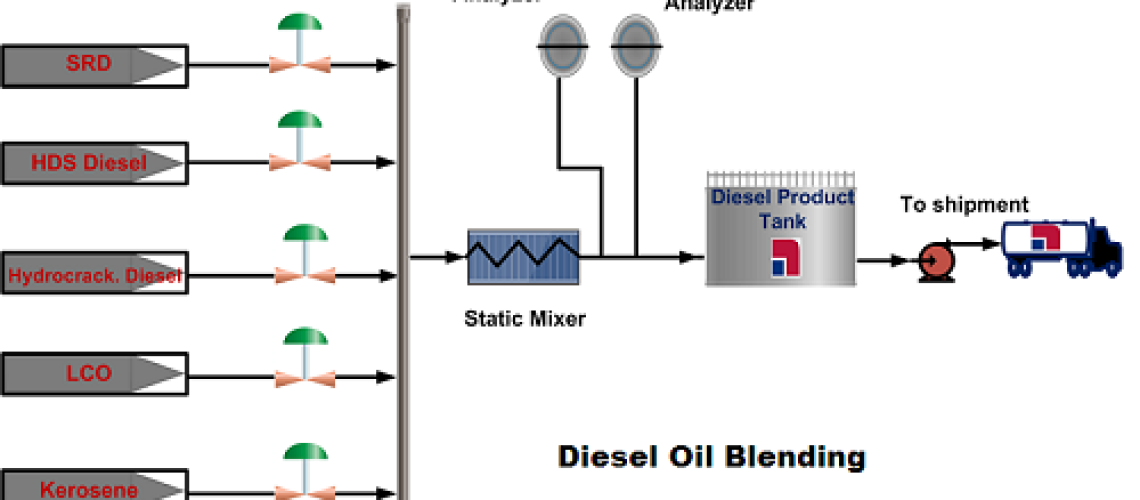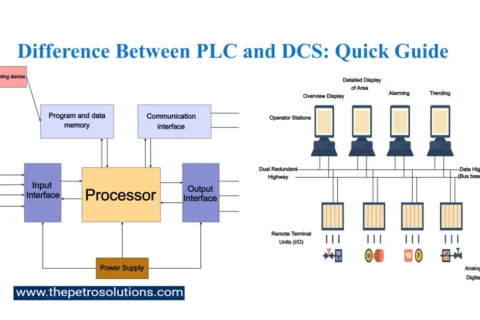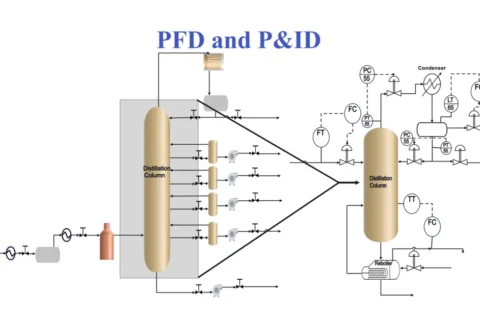Commercial diesel fuel is a blend of many refinery streams. Blending components of diesel product may come from straight run diesel and kerosene from the crude distillation column, desulfurized diesel from the hydrotreating unit, diesel stream from the residue hydrocracker, hydrotreated light cycle oil (LCO) from the FCCU unit, or hydrotreated coker gas oil and hydrotreated or MEROX treated kerosene. Diesel oil blending is mainly done to meet the diesel fuel specifications while utilizing various streams of the diesel range. This blog focuses on the operational actions performed to achieve the best results of diesel oil blending.

The purpose of diesel oil blending is to increase the refinery profit by utilizing maximum quantities of low-cost diesel components and achieving the required specifications with minimum give-away. Continuous Inline Blending is normally, adopted in oil refineries with the help of online analyzers and laboratory testing to verify the specifications before shipment.
There are numerous quality parameters of diesel products, but some parameters are of most importance like sulfur, flashpoint, distillation endpoint, lubricity property, etc. Other parameters like cetane index, copper strip, water, are included in the quality checks but always remain within range.

For most of the critical parameters, online analyzers are available otherwise lab testing in shifts is performed. To maintain the diesel pool specs, plant persons continuously monitor quality specs either online or through lab testing and adjust the plant parameters accordingly. Simple process of diesel oil blending in oil refinery can be seen below;

The key quality parameters of diesel blending and their control actions are described below;
1. Sulfur (wt ppm)
Sulfur content should be maintained near the upper limit of the specification to avoid possible giveaways. For e.g, Euro 5 diesel requires less than 10 ppm Sulfur, so it should be 7~8 ppm in the final product. In case the blended diesel sulfur is on the higher side then take the following actions
- Stop or reduce the direct streams like Kerosene or diesel to the blend. Similarly, reduce e or stop the flow of high sulfur streams in the diesel pool.
- Increase the reaction temperatures of the diesel hydrotreating unit. The rise in the rate of reaction reduces the sulfur component in the diesel product.
- If the above actions are not sufficient, then the WABT (Weighted Average Bed Temperature) of the residue hydrocracking unit can be increased, keeping in view the conditions of the unit.
- Other actions include, the crude oil with low sulfur can be added with crude feed to the crude distillation unit.
2. Flashpoint
The flashpoint of the Diesel product should be maintained near the specification. For example flashpoint of Euro 5 diesel is 55 C, so the control point should be ~60 C. Control actions for the flashpoint are as follows;
- Increase the stripping steam to the strippers in crude distillation unit, Diesel Hydrotreating, Hydrocracking unit, and LCO stripper in FCCU to improve the flashpoint
- Reducing or stopping the low flash point steams like kerosene to improve the flashpoint of the blend.
- If the above actions are not helping out then, Diesel can be made heavy to improve the flashpoint at the Crude Distillation unit, hydrocracking product fractionator, etc.
- The production of middle distillate or LCO at FCC unit has to be reduced to improve the flashpoint because maximizing middle distillate production, the FCCU gasoline endpoint would typically be minimized within middle distillate flash point constraints, shifting gasoline product into LCO.
3. 95 % Distillation point
The distillation shows the heaviness of petroleum products. For diesel, 95% distillation is normally controlled. As per Euro-V specifications, the 95 % distillation point is 360 oC. If the diesel is heavy and showing a 95 % distillation point greater than 360 oC, then the following actions can be taken to make it lighter ;
- Reduce the crude heater outlet temperature, this will reduce the rising of heavy vapors, thus making the diesel lighter.
- Increasing the hot reflux of the diesel section will condense and stop the lighter vapors from going up and making the diesel lighter.
- Reducing the kerosene draw out and dumping to the diesel section.
- If the above actions are still not sufficient, then diesel can be made lighter at the residue hydrocracking unit by increasing the WABT, reducing the conversion of the unit, reducing the diesel draw-off temperature.
- Make the LCO further lighter by reducing its production and temperature drop of LCO draw off at fractionator, etc.
4. Pour Point
Pour point indicates the stability of the fuel at low-temperature operations. It is the temperature below which wax crystals are formed due to the precipitation of paraffin, shows the cloudy appearance of diesel, and ceases to flow. This is an important parameter because precipitates of wax can clog the fuel filters and atomizers, resulting in poor performance of the engine.
Diesel fuels with high pour points can pose significant handling problems during low ambient temperatures due to wax separation in storage tanks and other handling equipment. To overcome this problem, diesel has been made lighter as discussed in 95 % distillation point control actions and dumping large volumes of kerosene in diesel to meet pour point specifications.
Moreover, pour point additives to lower the pour point of diesel fuel may present a cost-effective solution. Pour point additives are designed to interfere in the wax crystallization process by modifying the wax crystal structure. The other part of the additive, the molecule is dissimilar to the wax crystal and prevents the extensive growth of wax matrices. Most pour point depressant additives are polymers and copolymers of methyl acrylates of low molecular weight. The typical additive dosage is between 200 and 1000 ppm.
5. Lubricity Additives
The deep hydrodesulfurization of diesel fuel removes most of the sulfur and a significant amount of polar and aromatic compounds that give natural lubricity property. Loss of lubricity can cause engine problems due to the dryness of diesel fuel, mainly the erosion of diesel fuel injection equipment unless treated with lubricity additives.
For further details and discussion, please comment in the box below or contact at admin@






3 thoughts on “Diesel Oil Blending Process in Oil Refinery”
Blending diesel fuel plant detail